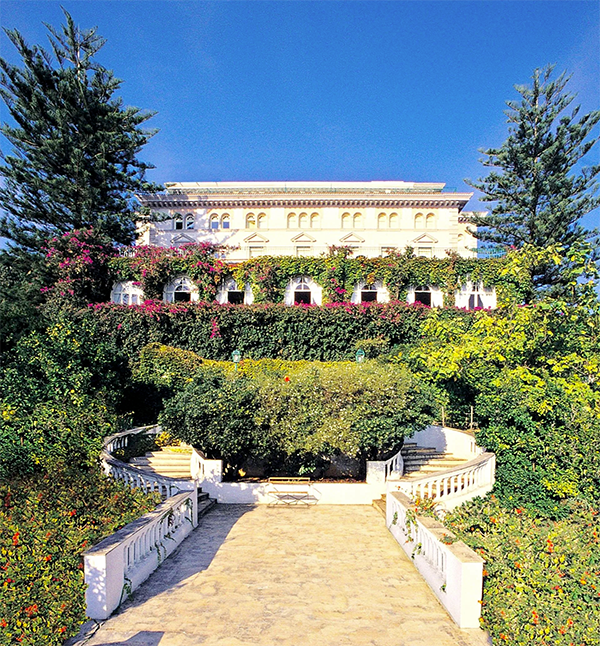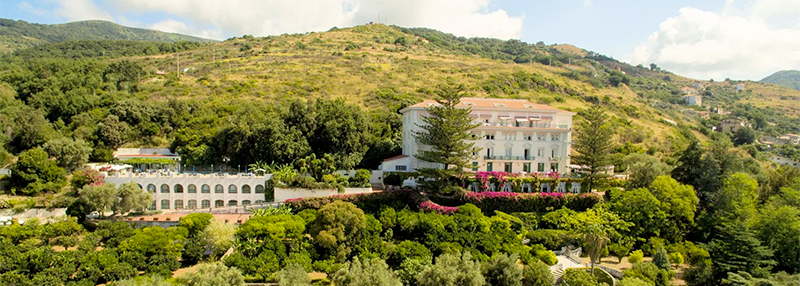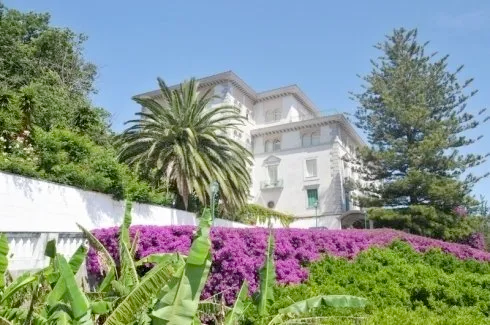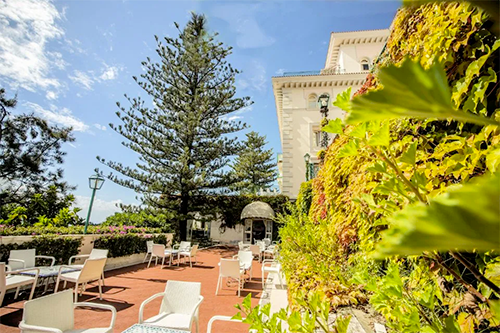An ECI Conference Series
Poster Dimension: Posters should be printed in A0 size, portrait format (84 cm wide by 118 cm high)

Grand Hotel San Michele
May 28 – June 2, 2023
Calabria, Italy
Post Conference Perspective Article
About This Conference
Alkali activated materials (AAM) and geopolymers are a class of inorganic polymers formed by the reaction between an alkali and an aluminosilicate source. They can be classified as those made from waste materials such as slag and fly ash, which produce cementitious (CSH-type) binders, and those made from calcined clays such as metakaolin or halloysite that produce geopolymers, or nanoporous, nanoparticulate solids consisting of cross-linked silicate and aluminate tetrahedra charge balanced by hydrated alkali ions. As seen in NMR, the former consist of Q2 and Q3 bonded silicate tetrahedra chains and hence are basically cementitious materials. The latter are Q4 bonded tetrahedra having an amorphous structure and are referred to as geopolymers.
Upon heating at temperatures up to ~1,000°C geopolymers convert to polycrystalline, stoichiometric, ceramic compounds with or without the presence of extra glassy phase, depending on their composition. When their composition is M2O•Al2O3•nSiO2 where M is a group I alkali, stoichiometric ceramic compounds can form such as nepheline (Na) or kalsilite (K) for n = 2 and leucite(K) or pollucite(Cs) for n=4. Acid activated geopolymers are also made by reacting phosphoric acid with metakaolin to form inorganic polymeric, alumino silicate phosphates of nominal composition Al2O3•P2O5•2SiO2. On heating to modest temperatures and higher, these crystallize into berlinite-type structures of aluminum phosphate and silicates which are also refractory and scalable.
As self-assembled, nanoporous, nanoparticulate, acid-resistant ceramics, geopolymers have wide potential applications as: fire-resistant structures or coatings, corrosion-resistant coatings; stronger and tougher replacements for cements and concretes; ceramic composites exhibiting “graceful failure” or pseudo-ductility; geopolymers containing glass frit can undergo amorphous self-healing when heated below 1000° (ASH-G) or behave as amorphous, self-healed ceramics when crystallized above 1000°C; nuclear radiation (a,b,g and neutron) shielding; electromagnetic pulse interference (EMI) shielding; porous water purification filters (eg. arsenic, cadmium); refractory glues between ceramics, metals, glass and/or wood); extremely high dielectrics, having dielectric constants up to 1000x higher than those of conventional electronic ceramics.
The alkali-activated, cementitious materials have an amorphous structure making them an ideal substitute for Portland cement in a wide range of applications. Many by-products resulting from high-volume industries can be used as feedstocks for alkali-activated cements (or more broadly, chemically-activated cements), including fly ash, mine tailings, metallurgical slags and bauxite residues.
Alkali activated geopolymers, particularly as refractory composites, have demonstrated desirable mechanical properties such as high flexure strength and toughness, good resistance to acid corrosion, heat and fire resistance up to 1200°C and possibly higher. They have found applications ranging from construction materials, waste immobilization for environmental and nuclear industries, as well as high-tech ceramics and composites such as porous insulators, porous filters for water purification, corrosion resistant metal coatings, 3D and 4D printed forms. Such stoichiometric geopolymers provide versatile, low energy pathways for the synthesis of normal and ultra-high temperature ceramics such as SiC, SiN, and SiAlONs as well as mullite (3Al2O3•2SiO2).
The key goal of the conference is to enable the transfer of information between specialists in these disparate areas of materials science and engineering:
• Significantly reduce greenhouse gas emissions in construction
• Improve the technical performance of materials used in construction, composites and related products
• Use large volumes of industrial (waste) by-products or low-value natural minerals in place of virgin resources
• Effectively immobilize hazardous, toxic and/or radioactive wastes
• Low energy syntheses of amorphous or crystalline ceramic nano-powders
• Versatile, low energy processing and forming routes for amorphous or polycrystalline ceramics and composites
This 3rd ECI International Conference, “GEOPOLYMERS and Alkali Activated Cements: Sustainable construction materials and ceramics made under ambient conditions”, planned for the year 2022, aims to collect scientific and industrial contributions, to find technical solutions enabling the application of geopolymers and related materials, to reduce waste and emissions in ceramic and cement manufacturing, and to provide high-performance, scalable, ceramic materials.
Those who have undertaken a significant research effort in this direction will be invited from all over the world to join the Conference. This will build from the high attendance and successful outcomes from the first ECI Geopolymers conference, which was held in Hernstein, Austria, in June 2015 and the second ECI Geopolymers conference held in Tomar, Portugal in May 29th – June 3rd (2018).
The further success of this conference series will represent a step toward meeting the global material needs of society with significantly reduced energy requirements as well as ecological impacts
Conference Organization
Conference Chairs
W.M. Kriven, University of Illinois at Urbana-Champaign, USA
Cristina Leonelli, Universita’ degli Studi di Modena e Reggio Emilia, Italy
John L. Provis, University of Sheffield, UK
Aldo R. Boccaccini, University of Erlangen-Nuremberg, Germany
International Scientific Committee
- Cyril Attwell, ARC Innovations, Benoni, South Africa
- Angel Palomo, Institute of Construction Science Eduardo Torroja (IETcc), CSIC, Madrid, Spain
- Paolo Colombo, University of Padua, Padua, Italy
- Vilma Ducman, Slovenian National Building and Civil Engineering Institute (ZAG), Ljubljana, Slovenia
- Claudio Ferone, University of Naples “Parthenope”, Naples, Italy
- Gregor Gluth, Federal Institute for Materials Research and Testing (BAM), Berlin, Germany
- Izabela Hager, Cracow University of Technology, Cracow, Poland
- Ana Paula Kirchheim, Universidade Federal do Rio Grande do Sul, Brazil
- Sylvie Rossignol, Ecole Nationale Supérieure de Céramique Industrielle, France
- Tero Luukkonen, Oulu Univesity, Oulu, Finland
- Jannie S. J. van Deventer, Zeobond Group, Australia
- Luis Pérez Villarejo, Universidad de Jaén, Jaén, Spain
- Guang Ye, TU Delft, Delft, The Netherlands
Call for Abstracts and Publication of Abstracts
Submission of Abstracts
One-page abstracts should be submitted as soon as possible and no later than the deadlines noted below. The abstract should include both the significance of the research as well as results that will be discussed to allow a scientific assessment of the work by the organizers. Please indicate if the abstract is for an oral or poster presentation. Only a limited number of oral presentation slots are available. Thus all submissions for oral presentations will be considered for both oral and poster.
Deadlines
Abstracts for oral presentation: February 22, 2023
Abstracts for poster presentations: February 22, 2023
Abstract acceptance deadline: March 15, 2023
All abstracts should be submitted electronically and submissions must follow the template: docx or doc.
In addition to the Abstract brochure, a selection of full manuscripts will be published as a special issue of the International Journal of Ceramics Engineering and Science which will publish open access at a reduced publication charge.
For inquiries on the publication charges, please contact Jonathon Foreman, Managing Editor, at jforeman@ceramics.org.
Submit your manuscript at https://mc.manuscriptcentral.com/ijces.
Venue Information

Cetraro and Grand Hotel San Michele
Cetraro Marina, a pleasant seaside resort is about two km from the Cetraro Commune of which it is a part. The ancient Citrarium (name derived from the abundant citrus cultivation in the area) was a center of the Bruzi rising between Paola and Capo Bonifati. Its coast location offers many interesting boat excursions.

The picturesque Grand Hotel San Michele is situated on the Tyrrhenian Coast, 120 meters above the Mediterranean Sea, with a fantastic view of Calabria’s southern coast. It offers visitors one of the prettiest locations Southern Italy has to offer and is considered by many to be one of Calabria’s finest hotels. Its beach (120 meters below the cliffs) is accessible only by a private special elevator. The hotel has a swimming pool, driving range, tennis court, minigolf, piano bar and billiard room.
The hotel is surrounded by an organic farm that provides the hotel with fresh organic food. Vegetables, fruits, olive oil, wine, milk, cheese, daily laid eggs, lamb, veal and pork meat, homemade jams and preserves are all produced on San Michele Hotel’s premises.

The acreage upon which the hotel is situated is also a bird sanctuary, where bird lovers from around Italy come to observe migratory patterns.
The maximum number of people that can be hosted in the hotel is about 80; however, there are other hotels in the area and the hotel can arrange pickups.
Pre and Post Conference Reservation Form
If you are arriving early or staying after the conference and wish to extend your stay in the conference hotel, please download and complete the Pre/Post Conference Reservation form posted below and send it directly to the conference hotel. ECI does not guarantee or pay for rooms reserved before or after the conference – you must reserve extra nights directly with the hotel and you are responsible for paying the hotel directly for any extra nights.
Conference Technical Excursion
We will be visiting the archaeological park and museum of Sybaris, one of the largest and most important sites in the Mediterranean of the archaic and classical age.

Archaeological park of Sybaris contains the remains of one of the most wealthy and important cities of Magna Graecia. It was the core of the ancient civilization of Oenotrians, developed over Iron Age, before Greeks came.
The History of Sybaris
Sybaris was founded in BC 730-720, when Achaeans got there and defeated and then enslaved native people. They settled down one of the most strategic cities of Magna Graecia, where the transit of goods from Asia Minor took place.
A flourishing trade was likely the reason that led to the battle of Traente (BC 510), won by Krotoniates, who first besiedge and then destroyed Sybaris in 70 days.
Survivors left for Greece, then Athens allowed them to get back to Calabria to settle a new Athenian colony, in the same place where Sybaris once rised, and they called it Thurii (BC 444). But after a domestic struggle with Athens, Sybarites were expelled for good.
The city was settled back again as the Roman colony of Copiae, which was soon re-named Thurii. Thanks to its breeding ground and good location, it had a central role for a long time and was occupied until Middle Ages.
The Archaeological Park of Sybaris
Visiting the Park of ancient city of Sybaris, will bring you back through the ages of Late antiquity, ancient Romans and finally of the Archaic Sybaris back to VIII century BC.
The area is divided into few sectors, each of which has been named after the corresponding dig site: Parco del Cavallo, a distric made up with two large plateion and one theatre; prolungamento Strada; Casabianca, a built area dating back to VI century BC, with a round tower; Stombi.
Excavations are not yet finished and ruins uncovered so far, which belong to the latest phase of archaeological dig, are the ones of the Roman city of Copiae. Besides, further research were taken in the surrounding area, at the borders of Sybaris plain, which brought back to light a necropolis dating from Iron Age, with goods from the period before the founding of the city, in Francavilla Marittima. Plus, a Greek sanctuary from the Archaic age was discovered on the top of the hill, an area that was yet occupied by native people who lived there before the Greeks.
Every artifact is stored in the National Archaeological Museum of Sibarite, not too far from the excavations lot.
Conference Fees and Registration
Conference Fees
All conference fees are inclusive. They include registration, accommodations (nights of Sunday (May 28), Monday (May 29), Tuesday (May 30), Wednesday (May 31) and Thursday (June 1)), all meals, excursion, taxes, and gratuities from the reception and dinner on Sunday through lunch on Friday. Incidental fees (telephone calls, faxes, spa, laundry, minibar etc.) are billed to your personal account by the hotel.
ALL PARTICIPANTS (INCLUDING MEMBERS OF THE ORGANIZING COMMITTEE AND INVITED SPEAKERS) ARE REQUIRED TO REGISTER.
The conference fees are:
| Register | Register | |
| Participant (single occupancy or sharing room with a guest; guest fee additional) | US $1,925 | US $2,125 |
| Participant (sharing a room with another participant) | US $1,740 | US $1,940 |
| Bona fide Graduate Student (sharing a room with another student) (Those in this category must upload proof of current status during registration – copy of current Student ID or a letter from your University confirming your student status) | US $1,300 | US $1,500 |
| Bona fide Graduate Student (single occupancy or sharing room with a guest; guest fee additional) (Those in this category must upload proof of current status during registration – copy of current Student ID or a letter from your University confirming your student status) | US $1,485 | US $1,685 |
| **Fees for Guest/accompanying person sharing bedroom with a participant. (Includes all conference included meals). Guests/accompanying persons may not attend technical sessions. | US $695 | US $695 |
If you plan to bring children to the conference, please contact Kathy Chan for pricing.
Conference Registration
You will need a login name and password to register for ECI conferences through our online system. If you have been a recent participant at an ECI conference or have submitted an online application or request for information about an ECI Conference, you may already have an account with us. If you know your login information, please use it.
If you are not sure whether you already have a login and password, please click on automated password retrieval and enter your e-mail address before creating a new account. If we don’t have a valid email address on file for you, a pop up window will appear stating that no records were found. Click “OK” and then follow the instructions to create a new account. If you have any questions or experience any difficulties, please email Kathy Chan.
Special Notes and Payment Instructions
We suggest that you register as soon as possible to be certain that you will have a hotel room at the conference rate.
All participants are encouraged to register before April 14,
2023. There is a discounted price for registering before this
date. Hotel space cannot be guaranteed for registrations received after
this date. Your registration is not
officially confirmed until we receive payment of the amount due and COVID-19
vaccination proof is verified by ECI staff. ECI reserves
the right to cancel your room registration if payment is not received or your
vaccination proof is invalid. Your invoice/receipt will automatically be
e-mailed upon of receipt of your registration. Should you need a signed
receipt, please contact Kathy
Chan.
Because of contractual guarantees made with the hotel for room and meal functions, no shows, late arrivals, missed meals and early departures cannot receive fee adjustments. If you have a disability and may require accommodation in order to participate fully in this conference, please indicate this when you register. An ECI representative will contact you to discuss your specific needs. If you have special dietary requirements (e.g., vegetarian or a food allergy), please make a note on your registration. The chef needs to know this information in advance if we are to accommodate you. ECI will attempt to accommodate special requests such as Kosher or Halal meals, but such meals may not be available at all conference sites. The participant must pay any additional costs for special meal requests that ECI pays a surcharge for.
Payment must be made by credit card (Visa, MasterCard, and Amex), check or money order drawn on a U.S. bank in U.S. dollars, payable to ENGINEERING CONFERENCES INTERNATIONAL. Checks or money orders in any other currencies are NOT ACCEPTABLE. Payment must be made on the web site except for those who are sending payment by wire transfer or have a purchase order from their company/institution.
WIRE TRANSFER PAYMENT: If you are planning to make payment by wire transfer, please contact Kathy Chan for the bank information. You must add $30 to cover ECI bank charges. Please reference your full name and the conference title. Please email a scanned copy to Kathy Chan. This is very important – otherwise it is extremely difficult to trace your payment and you may not receive a receipt prior to the conference.
Cancellation Policy: Cancellation must be received by ECI in writing at least 28 days prior to the start of the conference in order for a full refund (less a processing fee) to be considered. The ECI auditors require that refunds for all conference cancellations be processed after the conference so that the necessary back-up information (e.g., hotel list of those in-house) can be attached to the refund request and ECI can verify that the hotel has not charged a cancellation fee.
Cancellation fees:
- Cancellations received more than 28 days prior to the conference start date are subject to a processing fee of 4% of the total fee, plus any direct expenses incurred by ECI.
- Cancellations received 15 – 28 days prior to the conference start date are subject to a $250 cancellation fee plus any direct expenses incurred by ECI.
- Cancellations received 8 – 14 days prior to the conference start date are subject to a $500 cancellation fee plus any direct expenses incurred by ECI.
- No refunds will be issued for cancellations received less than 7 days prior to the conference start date.
- No refunds will be issued due to inclement weather or travel disruptions/cancellations.
Registrations may be transferred without incurring any penalty or cancellation fee.
Denied or delayed visa
If a participant is forced to cancel due to a denied or delayed entry visa, ECI will issue a full refund if ECI has been notified of a potential visa issue at least four weeks prior to the conference start date.
Change of payment method If an attendee who has already paid the conference fee with a credit card requests that the fee be refunded to that card so that it can be paid in a different manner (e.g., charged to an alternate credit card, or paid via check or bank transfer), a processing fee of 4% of the total fee amount will apply.
Transportation to Cetraro
By air
The most convenient airports are Lamezia Terme (87km), Naples (268km) and Rome Fiumicino or Ciampino (~470km). Note that the hotel can arrange for pick-ups from the Lamezia Terme airport. See below.
From Lamezia Terme airport to Paola
The airport is served by Air Baltic, Air France, Delta, KLM, Lufthansa, TAP and others.
- Take the bus to Lamezia Terme Centrale train station (travel time 5min, every 30min).
- Take the train to Paola (travel time ~30min, every couple of hours).
From Naples International airport to Paola
- Take the Alibus to Napoli Centrale train station (travel time 15/20min, every 15/20min).
- Take the train to Paola. Travel time: ~2h30 (intercity trains) to ~3h45 (local trains). Frequency: roughly every hour.
From Rome Fiumicino airport to Paola
- Take the Leonardo Express train to Rome Termini train station (travel time 32min, every 30min)
- Take the train to Paola (either direct or with a change in Naples). Travel time: ~3h to 4h (high-speed trains), ~5h to 5h30 (intercity trains). Frequency: roughly every hour
By train
The nearest major train station is Paola (25km) where all the fast trains make a stop
Italian train tickets can be booked with Trenitalia ( https://www.trenitalia.com/en.html)
If you are arriving by a local train from Naples, you can simply get off directly at Cetraro.
By auto
Use the Motorway Roma – Caserta Sud – Salarno – Lagonegro Nord – Fondo Valle Noce. (293 km)
Shuttle services
Lamezia Airport:
- Car (3 pax): euro 100 each way (Single passengers pay full euro 100 rate; two pay 50 euro each)
- Minibus (8 pax): euro 134 each way
Paola train station:
- Car (3 pax): euro 50 each way
- Minibus (8 pax): euro 80 each way
Cetraro Train Station:
- Car (3 pax): euro 10 each way
- Minibus (8 pax): euro 20 each way
Please note that for night shuttle services (between 1.00 am and 6.00 am) there is a 30€ supplement
Note: To facilitate shared trips to the hotel from the Lamezia Airport and both trains stations, please see Ground Transportation Reservation information below and send your information to the hotel by May 22.
Ground Transportation Reservation Information
Airline: The conference hotel can arrange transfers from Lamezia Terme Airport (SUF) to the hotel on Sunday, May 28, and transfers from the hotel to the airport on Friday, June 2. The cost will vary depending upon the number of attendees traveling together at the same time. The costs of transfers will be shared among those in the same vehicles. The costs (each way) are:
Car: 100 € (Up to 3 passengers) (1 passenger is 100 €; 2 passengers are 50 €/ passenger; 3 passengers are 34 €/passenger)
Minibus: 134 €: (up to 8 passengers – cost shared by number of passengers)
The cost will be billed to your incidental room charges.
Please note that for night shuttle services (between 1.00 am and 5.00 am) there is a 35 € supplement.
Note that if you arriving earlier than May 28 or plan to stay after the conference, the hotel can arrange transportation but most likely it will be on an individual basis.
If you would like to arrange a transfer, please email the following information:
– your name
– your email
– flight arrival and departure dates
– name of Airline, flight numbers, scheduled arrival/departure times
– number of people you are booking
to:
sanmichele@sanmichele.it no later than May 18.
Please note that you are attending the ECI conference from May 28-June 2.
The airport is 75 km from the hotel.
Train: The Paola Railway station is about 21 km from the hotel by ItaliaRail. Please email sanmichele@sanmichele.it by May 18 to arrange for a transfer to the hotel.
For those planning to take a train to Cetraro, please note that the hotel transportation is absolutely necessary as there are no taxis in Cetraro.
Sponsors
General Information about ECI
Engineering Conferences International (ECI) is a not-for-profit, global engineering conferences program, originally established in 1962 that provides opportunities for the exploration of problems and issues of concern to engineers and scientists from many disciplines.
The format of the conference provides morning and late afternoon or evening sessions in which major presentations are made. Poster sessions will be scheduled for evening discussion as well. Available time is included during the afternoons for ad hoc meetings, informal discussions, and/or recreation. This format is designed to enhance rapport among participants and promote dialogue on the development of the meeting. We believe the conferences have been instrumental in generating ideas and disseminating information to a greater extent than is possible through more conventional forums.
All participants are expected both to attend the entire conference and to contribute actively to the discussions. The recording/photographing of lectures and presentations is forbidden. As ECI conferences take place in an informal atmosphere, casual clothing is the usual attire.
Smoking is prohibited at ECI conferences and conference functions.

